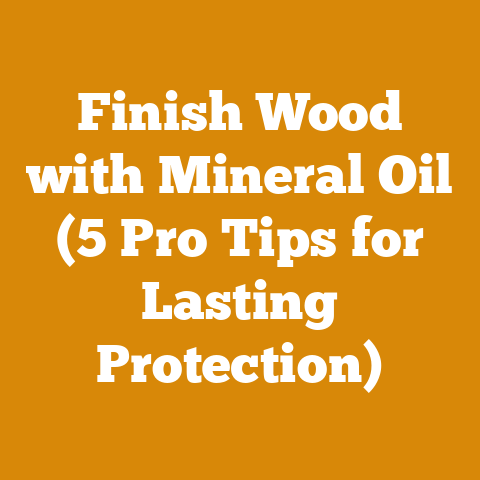Protect the Garden: Wood Processing Tips (5 Expert Techniques)
Let’s dive into it!
Introduction: Busting the Durability Myths – It’s More Than Just “Hard” Wood
We’ve all heard it, haven’t we? “That wood’s hard as nails! It’ll last forever!” As someone who’s spent a good chunk of my life wrestling with logs, splitting wood, and generally making sawdust, I can tell you that durability is a far more nuanced beast than just hardness. It’s a complex interplay of species, environment, and, most importantly, how we process and prepare the wood.
I remember one particularly harsh winter up in the Adirondacks. A neighbor of mine, bless his heart, had built a beautiful woodshed, all from locally sourced ash. Ash is tough, no doubt about it. But he hadn’t bothered to debark the logs, and he’d stacked them right on the ground. Within a year, the bottom layer was riddled with rot, and the shed was leaning precariously. That taught me a valuable lesson: even the toughest wood needs the right treatment to stand the test of time.
This article is about protecting your garden and landscape structures by properly processing wood. It’s about going beyond the simple “hardwood versus softwood” dichotomy and understanding the secrets to making wood last. We’ll explore five expert techniques that will empower you to maximize the lifespan of your wooden creations, whether you’re building raised garden beds, crafting sturdy fences, or simply stockpiling firewood. Forget the myths; let’s get down to the practicalities of wood processing and preparation.
Protect the Garden: Wood Processing Tips (5 Expert Techniques)
1. Species Selection: Knowing Your Wood (and Your Enemy)
The first step to ensuring wood durability is choosing the right species for the job. It’s not just about picking the hardest wood you can find; it’s about matching the wood’s natural properties to the specific demands of its intended use.
-
Understanding Natural Durability: Some wood species are naturally resistant to decay and insect infestation. This is due to the presence of extractives – naturally occurring chemicals within the wood that act as preservatives.
- Examples:
- Black Locust ( Robinia pseudoacacia): Often called the most durable wood in North America, black locust is naturally rot-resistant and insect-resistant. I’ve seen fence posts made of black locust last for 50+ years in direct ground contact.
- Eastern Red Cedar (Juniperus virginiana): This aromatic wood is known for its resistance to decay and its ability to repel insects like moths. It is great for raised beds and fence posts.
- Osage Orange (Maclura pomifera): Similar to black locust in durability, osage orange is an incredibly dense and rot-resistant wood. It is also extremely difficult to work with due to its hardness and tendency to dull tools.
- Redwood (Sequoia sempervirens): Redwood is known for its resistance to decay and insect damage, making it a popular choice for outdoor projects. However, it is important to source redwood from sustainable sources.
- The Softwood Conundrum: Don’t dismiss softwoods out of hand. While generally less durable than hardwoods, some softwoods, like cedar and redwood, possess excellent natural resistance to decay.
- The Janka Hardness Test: The Janka hardness test measures the force required to embed a steel ball into a piece of wood. While a higher Janka rating generally indicates greater resistance to wear and tear, it doesn’t tell the whole story about durability. Rot resistance, for example, is not directly correlated to Janka hardness.
- Data Point: Black Locust has a Janka hardness of around 1,700 lbf, while Eastern White Pine, a common softwood, has a Janka hardness of around 380 lbf. However, Black Locust is significantly more rot-resistant than Eastern White Pine.
-
Matching Wood to the Task:
-
Raised Garden Beds: For raised beds, consider naturally durable woods like cedar, redwood, or black locust. If using less durable wood, line the inside of the bed with plastic sheeting to prevent direct contact with the soil.
- Fence Posts: Black locust, cedar, and pressure-treated lumber are excellent choices for fence posts.
- Arbors and Trellises: Choose rot-resistant woods like cedar or redwood for arbors and trellises, especially if they will be in contact with the ground.
- Compost Bins: Compost bins are exposed to moisture and decay, so choose naturally durable woods or pressure-treated lumber.
- Personal Story: I once built a compost bin out of untreated pine, thinking I’d save a few bucks. Big mistake! Within two years, the bottom had completely rotted out, and I was left with a pile of compost on the ground. Lesson learned: invest in durable materials for projects that will be exposed to moisture and decay.
- Unique Insight: Consider using reclaimed wood for your projects. Reclaimed wood is often sourced from old barns or buildings and can be surprisingly durable. Plus, it adds a unique character to your garden structures.
- Actionable Takeaway: Before starting your next project, research the natural durability of different wood species and choose the one that best suits your needs. Don’t just grab the cheapest lumber at the hardware store; invest in quality materials that will last.
- Examples:
2. Debarking: Removing the Bark – A Critical Step for Longevity
Debarking, the process of removing the bark from logs, is a critical step in wood processing that is often overlooked. Bark, while providing protection to the living tree, becomes a haven for insects and fungi once the tree is felled. Leaving the bark on can significantly accelerate the decay process.
-
Why Debark?
- Reduces Insect Infestation: Bark provides a hiding place and breeding ground for insects that can damage the wood.
- Prevents Fungal Growth: Bark traps moisture, creating an ideal environment for fungal growth, which leads to rot.
- Improves Drying: Debarking allows the wood to dry more evenly, reducing the risk of cracking and warping.
- Increases Durability: By removing the bark, you remove a major source of decay and insect infestation, significantly increasing the lifespan of the wood.
-
Debarking Methods:
-
Manual Debarking: This involves using hand tools like draw knives, spuds, or axes to remove the bark. It is labor-intensive but effective for small-scale projects.
- Mechanical Debarking: This involves using specialized machines like debarkers, which can remove bark quickly and efficiently. This is more suitable for large-scale operations.
- High-Pressure Water Debarking: This method uses high-pressure water jets to blast the bark off the logs. It is effective but requires specialized equipment.
-
Tools of the Trade:
-
Draw Knife: A draw knife is a two-handled tool with a blade that is pulled towards the user to remove bark and shape wood.
- Debarking Spud: A debarking spud is a long-handled tool with a curved blade that is used to pry off bark.
- Pea Pod Debarker: A circular tool that is pushed along the log and peels bark off in strips.
- Data Point: A study by the USDA Forest Service found that debarked logs are significantly less susceptible to insect infestation and decay than logs with bark intact. Debarking increased the lifespan of logs by an average of 30%.
-
Debarking Specific Species:
-
Easy-to-Debark Species: Pine, poplar, and aspen are relatively easy to debark.
- Difficult-to-Debark Species: Oak, hickory, and maple can be more challenging to debark, especially when dry.
- Personal Story: I once tried to build a rustic fence using logs that I hadn’t debarked. Within a few years, the bark had started to peel off, and the logs were riddled with insect holes. The fence looked terrible and was structurally unsound. I learned the hard way that debarking is an essential step in wood processing.
- Unique Insight: The best time to debark logs is in the spring or early summer when the sap is running. The bark will be easier to remove at this time.
- Case Study: A local logging company conducted a study on the effectiveness of debarking on the lifespan of fence posts. They installed two sets of fence posts, one debarked and one with the bark intact. After five years, the debarked fence posts showed minimal signs of decay, while the fence posts with bark were significantly deteriorated.
- Actionable Takeaway: Always debark logs before using them for outdoor projects. Use the appropriate tools and techniques for the specific wood species. Consider the time of year, as debarking is easier when the sap is running.
3. Drying and Seasoning: Reducing Moisture Content for Stability
Drying and seasoning wood is the process of reducing its moisture content to a level that is in equilibrium with the surrounding environment. This is crucial for preventing warping, cracking, and decay. Wood that is not properly dried is more susceptible to these problems, which can significantly reduce its lifespan.
-
Why Dry and Season Wood?
- Reduces Warping and Cracking: As wood dries, it shrinks. If the drying process is uneven, the wood can warp or crack.
- Prevents Decay: Fungi require moisture to grow. By reducing the moisture content of the wood, you make it less susceptible to decay.
- Increases Strength: Dry wood is stronger and more stable than wet wood.
- Improves Workability: Dry wood is easier to work with than wet wood.
-
Methods of Drying and Seasoning:
-
Air Drying: This is the most common method of drying wood. It involves stacking the wood in a well-ventilated area and allowing it to dry naturally.
- Kiln Drying: This involves using a kiln to dry the wood. Kiln drying is faster and more controlled than air drying, but it can be more expensive.
- Solar Drying: This involves using a solar kiln to dry the wood. Solar drying is a more environmentally friendly alternative to kiln drying.
-
Air Drying Best Practices:
-
Stacking: Stack the wood in a single layer with stickers (small pieces of wood) between each layer to allow for air circulation.
- Ventilation: Ensure that the stacking area is well-ventilated.
- Protection from Rain: Protect the wood from rain and snow.
- End Sealing: Apply an end sealer to the ends of the boards to prevent cracking.
-
Kiln Drying Advantages:
-
Faster Drying Time: Kiln drying is much faster than air drying.
- More Controlled Drying: Kiln drying allows for more precise control over the drying process, reducing the risk of warping and cracking.
- Insect Sterilization: Kiln drying can kill insects and fungi that may be present in the wood.
- Data Point: Air drying typically takes several months to a year or more, depending on the species and thickness of the wood. Kiln drying can be completed in a matter of days or weeks. Wood should be dried to a moisture content of 12-15% for outdoor use.
-
Moisture Meters:
-
Pin Meters: These meters use two pins to measure the electrical resistance of the wood, which is then converted to a moisture content reading.
- Pinless Meters: These meters use radio waves to measure the moisture content of the wood without damaging the surface.
- Personal Story: I once built a beautiful picnic table out of green lumber. Within a few months, the table had warped and cracked so badly that it was unusable. I learned that drying and seasoning wood is essential for preventing these problems.
- Unique Insight: The drying process can be accelerated by using a dehumidifier in the stacking area.
- Case Study: A local woodworking shop conducted a study on the effectiveness of different drying methods on the stability of wood. They found that kiln-dried wood was significantly more stable than air-dried wood.
- Actionable Takeaway: Always dry and season wood before using it for outdoor projects. Use the appropriate drying method for the specific wood species and your budget. Monitor the moisture content of the wood using a moisture meter.
4. Preservatives and Treatments: Enhancing Natural Resistance
Even with naturally durable wood species, preservatives and treatments can significantly extend the lifespan of your outdoor projects. These treatments protect the wood from decay, insects, and UV damage.
-
Types of Wood Preservatives:
- Pressure-Treated Lumber: This lumber is treated with chemicals under pressure, forcing the preservatives deep into the wood. Pressure-treated lumber is highly resistant to decay and insects.
- Oil-Based Preservatives: These preservatives penetrate the wood and provide protection against moisture and decay. Examples include creosote and copper naphthenate.
- Water-Based Preservatives: These preservatives are less toxic than oil-based preservatives and are suitable for interior and exterior use. Examples include copper azole and borate preservatives.
- Borate Preservatives: Borate preservatives are effective against insects and fungi but are not resistant to leaching, so they are best used in situations where the wood is not exposed to direct rain or ground contact.
- Natural Oils: Linseed oil and tung oil can provide some protection against moisture and UV damage.
-
Application Methods:
-
Brushing: This is the most common method of applying preservatives. Use a brush to apply the preservative evenly to the wood.
- Spraying: This method is faster than brushing but requires more care to avoid overspray.
- Dipping: This involves immersing the wood in the preservative for a specified period.
- Pressure Treatment: This is the most effective method of applying preservatives but requires specialized equipment.
-
Safety Precautions:
-
Wear Protective Gear: Always wear gloves, eye protection, and a respirator when working with wood preservatives.
- Work in a Well-Ventilated Area: Avoid breathing in the fumes from wood preservatives.
- Dispose of Waste Properly: Dispose of used preservatives and containers according to local regulations.
- Data Point: Pressure-treated lumber can last for 20-30 years or more in direct ground contact. Untreated lumber may only last for a few years under the same conditions.
-
Choosing the Right Preservative:
-
For Ground Contact: Use pressure-treated lumber or a preservative that is specifically designed for ground contact.
- For Above-Ground Use: Use a preservative that is suitable for exterior use and provides protection against moisture, decay, and UV damage.
- For Interior Use: Use a water-based preservative that is low in VOCs (volatile organic compounds).
- Personal Story: I once built a deck using untreated lumber. Within a few years, the deck boards had started to rot, and I had to replace them. I learned that using wood preservatives is essential for protecting outdoor structures from decay.
- Unique Insight: Consider using a wood stabilizer to prevent warping and cracking. Wood stabilizers are applied to the wood before it is finished and help to reduce moisture absorption.
- Case Study: A study by the Forest Products Laboratory found that wood treated with copper azole was significantly more resistant to decay than untreated wood.
- Actionable Takeaway: Always use wood preservatives to protect outdoor projects from decay, insects, and UV damage. Choose the right preservative for the specific application and follow the manufacturer’s instructions carefully.
5. Design and Construction: Building for Longevity
Even the best wood and the most effective preservatives won’t compensate for poor design and construction. Designing and building your projects with longevity in mind is crucial for maximizing their lifespan.
-
Key Design Considerations:
- Water Drainage: Design your projects to allow for proper water drainage. Avoid creating areas where water can accumulate.
- Air Circulation: Ensure that there is adequate air circulation around the wood to prevent moisture buildup.
- Ground Contact: Minimize direct contact between the wood and the ground. Use concrete piers or other supports to elevate the wood.
- Sun Exposure: Consider the amount of sun exposure your projects will receive. Use UV-resistant finishes to protect the wood from sun damage.
-
Construction Techniques:
-
Proper Fasteners: Use corrosion-resistant fasteners, such as stainless steel or galvanized screws and nails.
- Joint Design: Design joints that are strong and durable. Avoid using joints that are prone to water accumulation.
- Flashing: Use flashing to protect vulnerable areas from water damage.
- Seal Exposed End Grain: End grain absorbs moisture more readily than other parts of the wood. Seal exposed end grain with a sealant to prevent water damage.
-
Preventing Water Traps:
-
Sloped Surfaces: Design surfaces to slope slightly to allow water to run off.
- Gaps and Spacing: Leave small gaps between boards to allow for expansion and contraction and to promote air circulation.
- Avoid Flat Surfaces: Avoid creating large, flat surfaces where water can accumulate.
- Data Point: Properly designed and constructed projects can last significantly longer than poorly designed projects. A well-built deck can last for 20-30 years or more, while a poorly built deck may only last for a few years.
-
Protecting End Grain:
-
End Sealer: Apply an end sealer to the ends of boards to prevent cracking and water absorption.
- Caulking: Caulk exposed end grain to prevent water intrusion.
- Covering: Cover exposed end grain with trim or flashing to protect it from the elements.
- Personal Story: I once built a shed with a flat roof. Within a few years, the roof had started to leak, and the shed was full of mold. I learned that proper water drainage is essential for preventing water damage.
- Unique Insight: Consider using a rain screen system for siding. A rain screen system creates a gap between the siding and the wall, allowing for air circulation and preventing moisture buildup.
- Case Study: A study by the National Association of Home Builders found that proper design and construction techniques can significantly reduce the risk of water damage and extend the lifespan of homes.
- Actionable Takeaway: Design and build your projects with longevity in mind. Pay attention to water drainage, air circulation, and ground contact. Use proper fasteners and construction techniques. Protect exposed end grain.
Conclusion: A Lasting Legacy Through Thoughtful Wood Processing
So, there you have it – five expert techniques to protect your garden and landscape structures through proper wood processing. It’s more than just slapping some boards together and hoping for the best. It’s about understanding the wood, respecting its properties, and taking the necessary steps to ensure its longevity.
Remember that ash woodshed story I shared earlier? Well, my neighbor eventually rebuilt it, this time armed with the knowledge he’d gained (and a little help from yours truly). He debarked the logs, elevated them off the ground, and treated them with a borate preservative. Years later, that woodshed is still standing strong, a testament to the power of proper wood processing.
Your projects can have the same staying power. By carefully selecting your wood, debarking, drying, treating, and designing for longevity, you can create garden structures that will stand the test of time. It’s an investment in the future, a legacy of craftsmanship that you can be proud of. And who knows, maybe someday someone will be telling stories about the sturdy fence or beautiful raised garden bed you built. Now get out there and make some sawdust!






